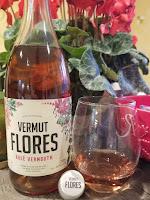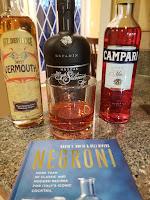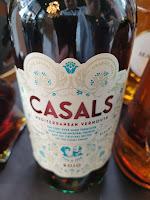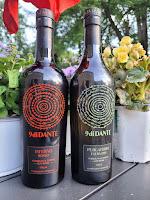My Dear Wormwood, ....
 Sipping absinthe or vermouth prompts me to mimic Uncle Screwtape when addressing his inexperienced nephew as I've grown fond of wormwood and the other aromatized herbs found in these beverages. Whereas the Artemisia absinthium herb is expected in absinthe, it shouldn't surprise consumers of its prevalence in vermouth. Consider that the term "vermouth" translates from English to German as wermut. Technically, Vermouth is a fortified wine that is aromatized -- meaning herbs, barks, citrus, or other ingredients are added for aroma and flavor -- and fortified with additional alcohol. The Kingdom of Savoy was a historical state that existed from 1416 to 1861 and was located in the western Alps, in what is now part of France, Italy, and Switzerland. the southern French part of the empire includes the Chambery region whereas the Italy section including Turin. Interestingly vermouth can be traced to both of these regions. Carpano was the very first vermouth brand, dating back to 1786 in Turin, Italy. In France, Noilly Prat in Marseillan was a dry style of vermouth, founded in 1813 whereas Dolin’s Vermouth de Chambéry was first identified as a distinct style in 1821.
Sipping absinthe or vermouth prompts me to mimic Uncle Screwtape when addressing his inexperienced nephew as I've grown fond of wormwood and the other aromatized herbs found in these beverages. Whereas the Artemisia absinthium herb is expected in absinthe, it shouldn't surprise consumers of its prevalence in vermouth. Consider that the term "vermouth" translates from English to German as wermut. Technically, Vermouth is a fortified wine that is aromatized -- meaning herbs, barks, citrus, or other ingredients are added for aroma and flavor -- and fortified with additional alcohol. The Kingdom of Savoy was a historical state that existed from 1416 to 1861 and was located in the western Alps, in what is now part of France, Italy, and Switzerland. the southern French part of the empire includes the Chambery region whereas the Italy section including Turin. Interestingly vermouth can be traced to both of these regions. Carpano was the very first vermouth brand, dating back to 1786 in Turin, Italy. In France, Noilly Prat in Marseillan was a dry style of vermouth, founded in 1813 whereas Dolin’s Vermouth de Chambéry was first identified as a distinct style in 1821.  In modern times, the European Union states that vermouth, as well as other aromatized wines, must include at least 75% wine in the finished product to which alcohol has been added (fortified) and have an ABV of 14.5–22%. In particular, vermouth is a product "whose characteristic taste has been obtained by the use of appropriate substances of Artemisia species". See ANNEX II. Vermouth comes in a range of sweetness levels, from extra dry (limited to a maximum sugar content of 30 grams per liter in the E.U.) through the semi-sweet blanc/blanco/bianco style, to sweet (minimum sugar content of 130 grams per liter in the E.U.). This later style is traditionally an ingredient to the classic Manhattan and Negroni. The blanc is traditionally used in Martinis whereas dry vermouth leads to a Dry Martini. All can be served over ice for those accustomed to a bitter and herbaceous profile.
In modern times, the European Union states that vermouth, as well as other aromatized wines, must include at least 75% wine in the finished product to which alcohol has been added (fortified) and have an ABV of 14.5–22%. In particular, vermouth is a product "whose characteristic taste has been obtained by the use of appropriate substances of Artemisia species". See ANNEX II. Vermouth comes in a range of sweetness levels, from extra dry (limited to a maximum sugar content of 30 grams per liter in the E.U.) through the semi-sweet blanc/blanco/bianco style, to sweet (minimum sugar content of 130 grams per liter in the E.U.). This later style is traditionally an ingredient to the classic Manhattan and Negroni. The blanc is traditionally used in Martinis whereas dry vermouth leads to a Dry Martini. All can be served over ice for those accustomed to a bitter and herbaceous profile.  My first consistent encounter with Vermouth began during the BevFluence Negroni book campaign where David T. Smith and Keli Rivers published dozens of recipes. Then came an Italian vacation consuming more Negronis and dry or sweet vermouth on ice with a twist of lime, as well as various Amaros. I was hooked.
My first consistent encounter with Vermouth began during the BevFluence Negroni book campaign where David T. Smith and Keli Rivers published dozens of recipes. Then came an Italian vacation consuming more Negronis and dry or sweet vermouth on ice with a twist of lime, as well as various Amaros. I was hooked. One of my favorites is from Uruguay in the Vermut Flores Rosé NV Canelones where Basta Spirit uses Tannat as a base augmented by 27 botanicals, including flowers such as hops, chamomile, rose, and elderberry. It is extremely aromatic, with plenty of herbaceousness and forest spiciness - very gin-like.
 At a recent Spain's Great Match trade tasting I became infatuated with the Casals Vermouth - the first Vermouth made with ancestral Catalan white grape varietals, enhanced with 20 Mediterranean botanicals from Penedés, Spain. A fantastic sipping rum from Torres Distillery and available by the glass at Del Mar Restaurant at the District Wharf.
At a recent Spain's Great Match trade tasting I became infatuated with the Casals Vermouth - the first Vermouth made with ancestral Catalan white grape varietals, enhanced with 20 Mediterranean botanicals from Penedés, Spain. A fantastic sipping rum from Torres Distillery and available by the glass at Del Mar Restaurant at the District Wharf. At this event I was also able to reacquaint myself with the sherry inspired vermouth from Jerez and Gonzalez Byass. The La Copa Vermouth starts with an Oloroso Fino sherry base (100% Palomino) that is created by oxidative aging. The wine is fortified early, suppressing the flor yeast which typically protects against oxidation. This vermouth is aromatized with wormwood, various herbs, dried fruit, and spices. The sweeter La Copa Rojo Vermouth is an eight-year-old blend of 75% Palomino and 25% Pedro Ximénez with traditional botanicals including wormwood, cinnamon, orange peel, and nutmeg.
 Closer to home in Middleburg Virginia, Mt. Defiance Distillery produces an interesting Sweet Vermouth that I realized very quickly was too unique to use in a Negroni. This vermouth starts with botanicals and spices infused into their Mt. Defiance Apple Brandy that they say "extracts flavors from herbs we grow ourselves and spices from around the world. This flavored base is then blended with barrel-aged brandy, Vidal Blanc wine, local honey, and caramel syrup. Not a traditional recipe so serve over ice and enjoy.
Closer to home in Middleburg Virginia, Mt. Defiance Distillery produces an interesting Sweet Vermouth that I realized very quickly was too unique to use in a Negroni. This vermouth starts with botanicals and spices infused into their Mt. Defiance Apple Brandy that they say "extracts flavors from herbs we grow ourselves and spices from around the world. This flavored base is then blended with barrel-aged brandy, Vidal Blanc wine, local honey, and caramel syrup. Not a traditional recipe so serve over ice and enjoy. And finally, I recently received samples of two vermouths from one of the historic homelands of the beverage -- 9diDANTE. The Purgatorio Extra Dry Vermouth di Torino Superiore IGP and Inferno Rosso Vermouth di Torino Superiore IGP are produced at the historic Dr. M. Montanaro Distillery in Piedmont. Collaborators Alex Ouziel and Mario Baralis are one of few producers in the Turin region to use 100% DOC Piedmontese wines, made entirely from native grapes -- Dolcetto/Cortese for the red Inferno and Arneis for the extra dry Purgatorio . Each vermouth contains 27 botanicals with the major contributors aligning to Dante's classical interpretation of levels of the afterlife. I enjoyed the Inferno chilled and the Purgatorio over ice with either a twist of lime or orange. Expect a longer post n mid-June with thoughts from Mr. Ouziel
